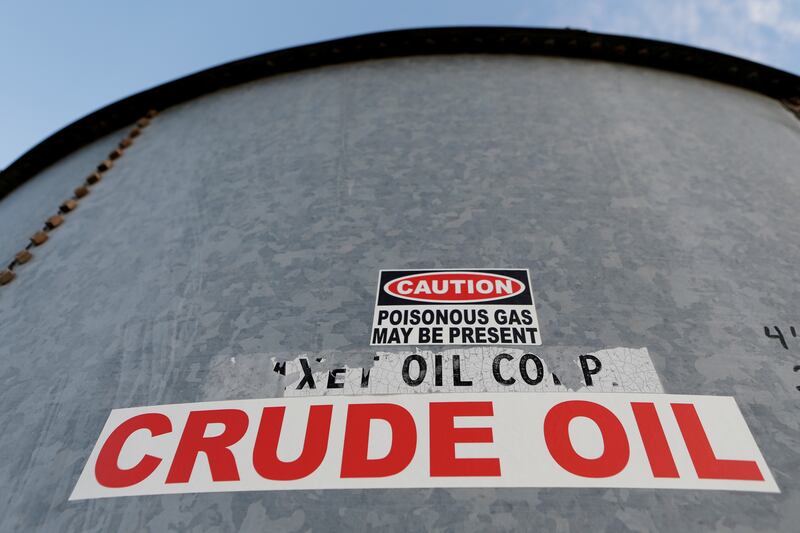Oil prices edged higher on Monday after losing steam last week due to tight market conditions and few material takeaways for the energy industry from US President Joe Biden’s visit to the Middle East.
Both Brent, the benchmark for two thirds of the world's oil, and West Texas Intermediate, the gauge that tracks US crude, recovered from steep declines Tuesday last week when Brent fell by about 7 per cent and WTI plummeted 8 per cent.
Brent was up 2.78 per cent at $104 at 12.11pm UAE time on Monday. WTI gained 2.57 per cent to $100.10 a barrel.
“Crude oil prices continue to remain unfazed by Biden’s visit to Saudi Arabia,” said Naeem Aslam, chief market analyst at Avatrade.
“Last week’s sell-off became an opportunity for many as investors are still betting that oil prices are unlikely to drop significantly anytime soon. Traders got one clear message from Biden’s recent visit to Saudi Arabia … the message is that it is Opec that makes the oil supply decision [that] Opec+ will continue to control oil supply, and one country alone cannot determine the oil supply.”
During his address to the US-Arab summit in Jeddah, Saudi Crown Prince Mohammed bin Salman repeated that the kingdom, the world's biggest exporter of crude, will not have any additional production capacity beyond the 13 million barrels per day it is aiming for by 2027.
World oil demand is expected to exceed pre-coronavirus levels in 2022 but the Russia-Ukraine war, coronavirus-related developments and inflationary pressures are posing headwinds.
Higher commodity prices and supply chain disruptions are stoking inflation, economic uncertainty and fears of a global recession.
Last week, Opec said in its monthly oil market report that it expects a market deficit of about 1 million bpd in 2023.
In its monthly report, the International Energy Agency cut its demand outlook for 2022 and 2023 due to higher crude prices starting to “dent oil consumption”, even as China begins to ease Covid-19 restrictions in a move that could spur demand for the remainder of this year.
Meanwhile, the US Energy Information Administration reported that crude oil stocks increased by 3.3 million barrels for the week ending July 8, compared with a build of 8.2 million barrels estimated for the previous week.
“Oil demand concerns due to recession fears, a stronger US dollar and the unwinding of the 'oil inflation hedge' have triggered [a] liquidation” in oil positions by financial investors, UBS strategists Giovanni Staunovo and Wayne Gordon said.
The US dollar retreated on Monday after closing in on a 20-year high last week against its rivals. The dollar index was steady at 107.830, compared with last week's high of 109.290, according to Reuters data.
Europe's plan to cut about 3 million bpd of crude oil and oil product imports from Russia by the end of the year will tighten the market further, UBS said.
“We think prices need to rise higher to trigger demand destruction and bring supply and demand back into balance,” Mr Staunovo and Mr Gordon of UBS said.
“We continue to advise risk-taking investors to add long positions in longer-dated oil contracts in Brent or to sell Brent’s downside price risks.”
Jeffrey Halley, a senior market analyst at Oanda said “supply risks remain evident in international markets … [and] despite the ructions in the speculative futures markets, the real-world dynamic remains as supportive of oil prices as ever. If Russia doesn’t switch gas exports back on to Europe at the end of the week, Brent crude could once again, find itself back near $110 a barrel”.
Market dynamics, the pandemic and the Ukraine war, now in its fifth month, have prompted the International Monetary Fund, the World Bank and the Institute of International Finance to cut their forecasts for the global economy this year.
The rising risk of a recession, broad-based inflation and subsequent interest rate increases are weighing on the economic recovery and recent economic indicators imply a “weak second quarter, and we will be projecting a further downgrade” to both 2022 and 2023 global growth in the World Economic Outlook Update, IMF managing director Kristalina Georgieva said last week.
The update will be released later this month, she said.
The World Bank forecasts that the global economy will grow 2.9 per cent this year, lower than the 3.2 per cent projection it issued in April, while the IMF expects it to grow 3.6 per cent, down from its previous 4.4 per cent estimate in January.
“Further disruption in the natural gas supply to Europe could plunge many economies into recession and trigger a global energy crisis. This is just one of the factors that could worsen an already difficult situation,” Ms Georgieva said.







